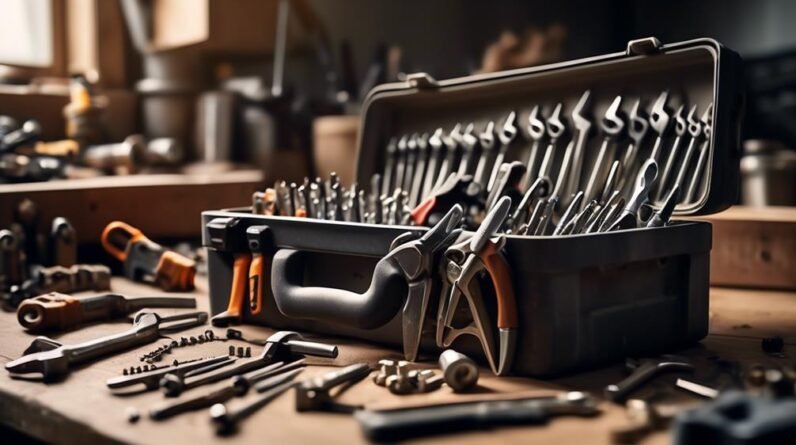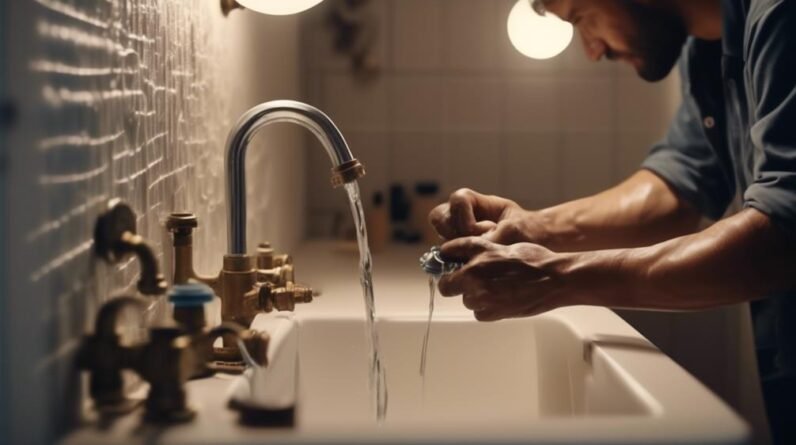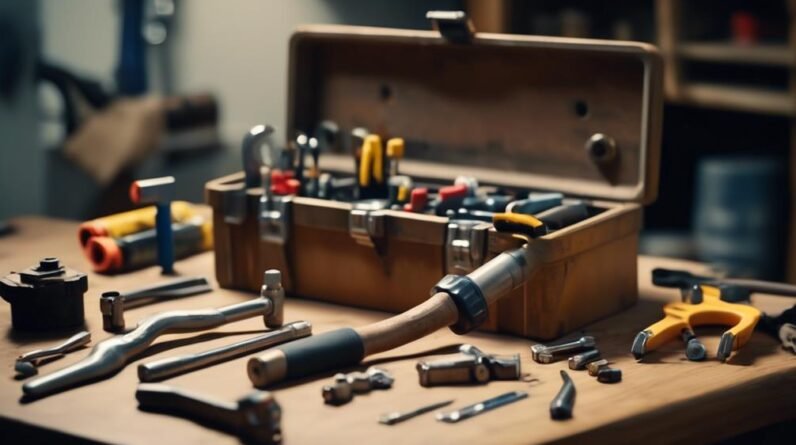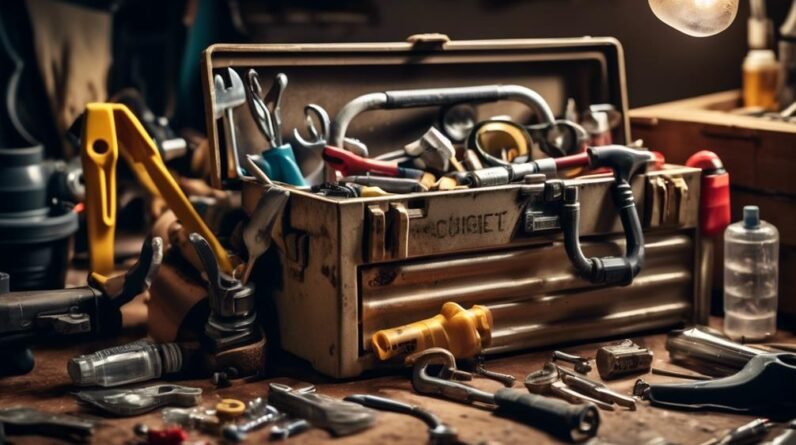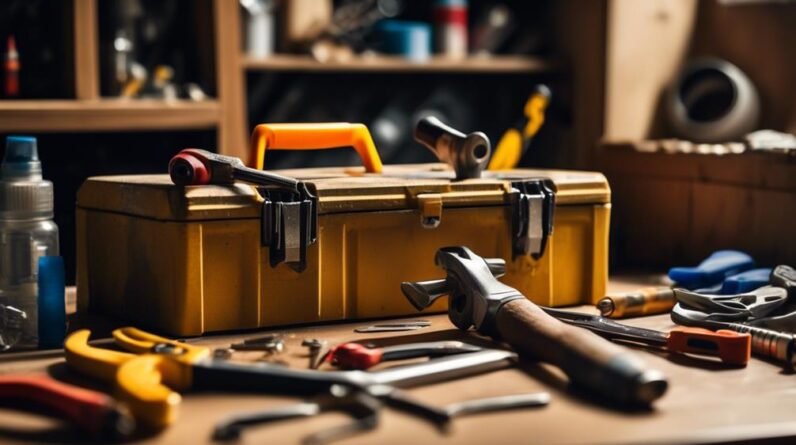
Are you a novice in need of practical tips to tackle those pesky home repairs? Look no further! We present to you the 5 best beginner-friendly home repair hacks that will have you feeling like a pro in no time. From fixing a leaky faucet to unclogging a drain, these hacks cover a range of common household issues. But that's not all – we've got a bonus hack for beginners who want to give their walls a fresh coat of paint. So, are you ready to discover the secrets to successful home repair projects? Stay tuned to find out how these hacks can make your life easier and your home more functional.
Key Takeaways
- Proper diagnosis is crucial in home repairs. Identify the cause of the issue before attempting to fix it.
- Turn off the water supply or power source before starting any repairs to ensure safety.
- Regular maintenance and lubrication can prevent common problems like squeaky doors.
- When repairing tiles, make sure to use the appropriate adhesive and follow the manufacturer's instructions for drying time.
Fixing a Leaky Faucet
If you notice a leaky faucet in your home, don't worry – fixing it is easier than you might think. A leaky faucet can be quite annoying, causing water wastage and increasing your water bill. However, with a few simple steps, you can troubleshoot and fix the problem yourself.
First, you'll need to determine the cause of the leak. The most common reasons for a leaky faucet are worn-out washers or O-rings, a faulty cartridge, or a loose valve. Start by turning off the water supply to the faucet. This can usually be done by locating the shut-off valve under the sink. Once the water is off, you can disassemble the faucet using a screwdriver or an adjustable wrench. Inspect the washers, O-rings, and cartridge for any signs of damage or wear. If you find any issues, replace the faulty parts with new ones from your local hardware store.
After replacing the necessary parts, reassemble the faucet and turn the water supply back on. Check for any leaks and ensure that the faucet is functioning properly. If the leak persists, it may be best to consult a professional plumber to identify and fix the problem.
Fixing a leaky faucet is a simple and cost-effective home repair task that can save you money and prevent further water damage. With a little bit of know-how and the right tools, you can easily tackle this common household issue.
Repairing a Squeaky Door
Does your door squeak every time you open or close it? Don't worry, fixing a squeaky door is easier than you think. The two main culprits behind a squeaky door are lack of lubrication on the hinges and misalignment of the door. To start, apply a lubricant such as WD-40 or silicone spray to the hinges. Make sure to open and close the door a few times to distribute the lubricant evenly. If the squeaking persists, you may need to adjust the alignment of the door. Begin by tightening or loosening the screws on the hinges to see if that solves the issue. If not, you can place a piece of cardboard or a matchstick in the hinge to create a tighter fit. Remember to test the door after each adjustment to ensure the squeaking has stopped. With these simple steps, you can say goodbye to that annoying squeak and enjoy a smooth, silent door.
Patching a Cracked Tile
To patch a cracked tile, gather the necessary materials and follow these simple steps. Start by removing the broken tile carefully. Use a chisel and a hammer to carefully chip away the grout surrounding the cracked tile. Once the grout is removed, gently pry the tile away from the surface using the chisel. Be cautious not to damage the surrounding tiles or the countertop.
Next, inspect the exposed area to ensure it is clean and free of debris. If necessary, use a vacuum or a brush to remove any loose particles. Once the area is clean, apply a thin layer of tile adhesive using a notched trowel. Make sure to spread the adhesive evenly over the exposed area.
Now, it's time to replace the broken tile. Press the new tile firmly into the adhesive, aligning it with the surrounding tiles. Use a tile spacer to maintain an even gap between the tiles. Allow the adhesive to dry according to the manufacturer's instructions.
Unclogging a Drain
To unclog a drain, gather the necessary tools and follow these simple steps. First, you'll need the right drain cleaning tools. A plunger is a must-have for any clog. It creates suction and pressure to dislodge blockages. Another tool to consider is a drain snake or auger, which can help break up stubborn clogs.
Now that you have your tools ready, here are three natural drain unclogging methods to try:
- Baking Soda and Vinegar: Start by pouring half a cup of baking soda down the drain, followed by half a cup of vinegar. Let it sit for a few minutes, then flush with hot water. The chemical reaction between the baking soda and vinegar can help dissolve the clog.
- Hot Water Flush: Boil a pot of water and carefully pour it down the drain in stages. The hot water can help melt away grease and other substances causing the clog.
- Salt and Hot Water: Mix half a cup of salt with a pot of hot water. Stir until the salt dissolves and pour it down the drain. Let it sit for a while before flushing with more hot water. The salt can help break down the clog and clear the drain.
Painting Tips for Beginners
If you're new to painting, here are some helpful tips to get you started. First, when choosing the right paint colors, consider the mood and atmosphere you want to create in the room. Lighter colors can make a space feel more open and airy, while darker colors can add depth and coziness. Look for inspiration online or in home decor magazines to find colors that resonate with you.
Next, preparing the surface for painting is crucial for a smooth and professional finish. Start by cleaning the walls or surface you'll be painting to remove any dirt, dust, or grease. Fill in any cracks or holes with spackle and sand them down until they're smooth. Use painter's tape to protect trim, windows, and other areas you don't want to get paint on.
Once the surface is prepped, it's time to start painting. Use a high-quality brush or roller for best results. Start with a primer if needed, and apply it evenly to create a smooth base. When applying the paint, use long, even strokes and work from top to bottom. Allow each coat to dry completely before applying the next one.
Frequently Asked Questions
How Do I Know if a Leaky Faucet Is a DIY Fix or if I Need to Call a Professional Plumber?
If you have a leaky faucet, start by checking if it's a simple fix like a worn-out washer. If you're unsure or don't have the necessary tools, it's best to call a professional plumber for help.
Can I Use WD-40 to Fix a Squeaky Door, or Is There a More Effective Method?
You can use WD-40 to fix a squeaky door, but there are more effective alternatives. Lubricants like silicone spray or graphite powder work better and last longer. Try them for a smoother, long-lasting solution.
Is It Possible to Patch a Cracked Tile Without Having to Replace the Entire Tile?
You can patch a cracked tile without replacing the whole thing. Use a tile repair kit or epoxy adhesive to fill in the crack. Remember to clean the area and follow the instructions for the best results.
What Are Some Common Household Items That Can Be Used to Unclog a Drain Before Resorting to Chemical Drain Cleaners?
Before resorting to chemical drain cleaners, try using common household items like baking soda, vinegar, and a plunger to unclog your drain. These alternative methods are effective and beginner-friendly.
Is It Necessary to Prime the Walls Before Painting, or Can I Skip This Step as a Beginner?
As a beginner, you may wonder if it's necessary to use primer before painting. Well, using primer is highly recommended as it helps to create a smooth, long-lasting finish. Skipping this step may result in an uneven and less durable paint job.
Conclusion
In conclusion, these five beginner-friendly home repair hacks are essential for any homeowner looking to save time and money. By fixing a leaky faucet, repairing a squeaky door, patching a cracked tile, unclogging a drain, and following painting tips for beginners, you can tackle common household issues with confidence. With these expert tips, you'll be well on your way to becoming a skilled DIY homeowner.


